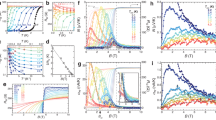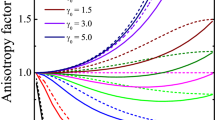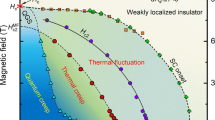Abstract
We propose a Lagrangian function, which combines Landau-Ginzburg term and Chern-Simons term, for describing the competition between disorder and superconductivity. To describe the normal-to-superconducting transition in the thin superconducting films, we apply Wilson’s renormalization group methods into this Lagrangian function. Finally, we obtain a scaling law between critical temperature (Tc), film thickness (d), sheet resistance of the film at the normal state (Rs) and number density of the electrons at the normal state (N). Such a scaling law is in agreement with recent experimental investigations [Ivry, Y. et al., Physical Review B 90, 214515 (2014)]. Our finding may have potential benefits for improving transition temperature Tc.
Similar content being viewed by others
Introduction
Exploring the mechanism of triggering high-Tc superconductivity is an important task. It has attracted many attentions over the past 30 years and causes a lot of works. Even so, the mechanism of triggering high-Tc superconductivity still remains largely a mystery1. However, thin superconducting films are believed to facilitate the comprehension of high-Tc superconductivity, since they allow an inherent competition between disorder and superconductivity which in turn enables the intriguing superconducting-to-insulating transition. Recently, by analyzing the data published over the past 46 years for different materials, Ivry et al. discovered a universal relationship2 between critical temperature (Tc), film thickness (d) and sheet resistance of the film at the normal state (Rs):

where, A and B are fitting parameters and  .
.
Although the scaling formula (1) may provide a theoretical basis for improving the transition temperature Tc, Ivry et al.2 also stressed that this formula cannot be derived by using existing theories3,4,5,6. The main purpose of this paper is to investigate the possible origin of the formula (1) by using Wilson’s renormalization group methods.
Competition between disorder and superconductivity
As is well known, renormalization group is a powerful tool of dealing with critical phenomena. The scaling formula (1) associates the transition temperature Tc with the sheet resistance of the film at the normal state Rs. To apply the renormalization group methods, it is natural to seek a Lagrangian function, in which Rs and Tc will emerge as the possible coefficients, for describing the competition between disorder and superconductivity. To this end, let us consider superconducting state and normal state, respectively.
(1) Superconducting state. As is well known, the superconducting state can be described by the Landau-Ginzburg Lagrangian function in 3-dimensional space:

where, Aμ denotes the electromagnetic potential, ϕ denotes the order parameter and Fμν = ∂μAν − ∂νAμ.
(2) Normal state. To describe the normal state we propose to consider the following Lagrangian function in 3-dimensional space:

where, εμνλ denotes the totally antisymmetric symbol in 3-dimensional space and Jμ denotes the current density.
Applying Euler-Lagrange variational procedure into the Lagrangian function (3) yields:

In 2 + 1 dimensional space-time the coefficient σ of Chern-Simons term plays the role with order parameter7 and has the physical meaning of Hall conductivity7,8,9. In fact, for 2 + 1 dimensional space-time the eq. (4) reproduces Ohm-Hall law10 in which the coefficient σ stands for Hall conductivity. It is well known that Ohm’s law describes the normal state well. We hope that the eq. (4) for 3-dimensional space can be also used to describe the normal state. Remarkably, Hill11 has pointed out that the coefficient σ in 3-dimensional space must approach the coefficient of Chern-Simons term in 2 + 1 dimensional space-time; otherwise, there will be inconsistencies (see page 5 in ref. 11). Therefore, the coefficient σ in 3-dimensional space can still be thought of as the Hall conductivity.
On the other hand, because this paper considers 3-dimensional space rather than 2 + 1 dimensional space-time, we do not worry that the Chern-Simons term will break time reversal symmetry. Regarding the existence of 3-dimensional Chern-Simons term, we adopt Hill’s argument11: “D-odd Chern-Simons term in a U(1) theory exists at all and what it is physically measuring, i.e., the world-line intersection of Dirac branes”.
If we consider the limit ωτ ≫ 1, the resistivity ρ can be written as (see page 1 in ref. 12):

where ω denotes the angular frequency of the cyclotron motion and τ denotes the scattering relaxation time.
To describe the competition between disorder and superconductivity, we expect that the Lagrangian functions (2) and (3) can hold simultaneously in the neighborhood of the superconducting-to-insulating transition point Tc. Without loss of generality, we assume that the collective behaviors of electrons around the critical point Tc can be described by the following Lagrangian function:

The Lagrangian function (6) will be the starting point of this paper. It is carefully noted that by our assumption the Lagrangian function (6) only holds in the infinitesimal neighborhood of Tc, since the Lagrangian functions (2) and (3) may be invalid in insulating state and superconducting state, respectively. Therefore, the Lagrangian function (6) indeed implies the competition between disorder (non-zero ρ) and superconductivity (non-zero ϕ). However, we need to clarify: we do not investigate what drives the superconducting-to-insulating transition. In fact, we are only interested in what critical behavior will occur around the transition point. From this meaning, our research is merely a phenomenological work.
Renormalization-group equations
Renormalization group approach is a powerful tool of dealing with critical behaviors. We hope that this approach can reproduce the scaling formula (1). To this end, let us apply renormalization group approach into the Lagrangian function (6).
Adopting the standard procedure of renormalization group we first write down the path integral (see page 396 in ref. 13):

where D denotes the number of space dimensions.
Let us define

and

where “s” stands for “smooth” part and “w” stands for “wriggly” part.
Substituting eqs (8) and (9) into eq. (7) yields:

If we do the integral over ϕw and  , then eq. (10) can be rewritten in the form:
, then eq. (10) can be rewritten in the form:

where,

Here Δλ2, Δλ4, ΔE, Δq, Δσ and ΔF stand for perturbative terms. Regarding the origin of perturbative terms Δλ2, Δλ4 and ΔE, we adopt Peskin’s derivation, refer to equation (12.20) in ref. 13.
In terms of the rescaled variable x′ = bx, eq. (12) becomes

where we have used  and
and  .
.
If we rescale the fields ϕs and  according to:
according to:

and

then eq. (13) can be rewritten in the form:

which shares the same form with Lagrangian function (6).
The new parameters of the Lagrangian function (14) are:




The attention of this paper will be concentrated on the eqs (17) and (18). All of the corrections, Δλ4, ΔE, Δσ, ΔF and so on, should be small compared to the leading terms if perturbation theory is justified. This paper only considers the simplest case where the corrections will be ignored. Therefore, eqs (17) and (18) can be rewritten as:


Substituting b = 1 + (δl)/(l) into eqs (19) and (20) we easily get the first-order renormalization group equations:


where l is a length somewhat larger than atomic dimensions14.
Results
Let us solve the scaling equations from the renormalization-group eqs (21) and (22):


where λ0 and σ0 are undetermined parameters.
Substituting eqs (5) and (23) into eq. (24) we get:

By Bardeen-Cooper-Schrieffer (BCS) Hamiltonian of superconductivity Gorkov15 has shown that the Landau-Ginzburg equations in 3-dimensional space can be written in the form:

which by rescaling ψ(r) according to ϕ(r) = (1)/((2m*)1/2)ψ(r) yields the following Lagrangian function:

where  (ζ(x) is Riemann’s zeta function and εF denotes Fermi energy) and N is number density of the electrons at the normal state15.
(ζ(x) is Riemann’s zeta function and εF denotes Fermi energy) and N is number density of the electrons at the normal state15.
Comparing Lagrangian functions (6) and (27) we obtain:


Comparison of Lagrangian functions (6) and (27) is a key point of obtaining the main result of this paper. Then, a question may arise: “Lagrangian functions (6) and (27) cannot be considered equivalent because Lagrangian function (27) is derived by BCS Hamiltonian, which does not include the Chern-Simons term”. However, we must clarify that Lagrangian functions (6) and (27) are not considered equivalent in our derivation. In fact, we only assume that Lagrangian functions (6) and (27) share the same coefficients λ2 and λ4. Such an assumption has been confirmed by Gorkov’s derivation. In his famous article15, Gorkov has taken into account BCS Hamiltonian including electromagnetic field. Specifically, Gorkov introduced the electromagnetic field Aμ into BCS Hamiltonian by using “Principle of Local Gauge Invariance”; while, in such a treatment, neither Maxwell term FμνFμν nor Chern-Simons term εμνλAμ∂νAλ produce a change in his differential equation for the thermodynamic Green functions. Therefore, the coefficients λ2 and λ4 will not receive any substantial contributions from Maxwell term or Chern-Simons term. The readers can realize this point by checking the eq. (1) in ref. 15.
Substituting eq. (29) into eq. (25) yields:

The thin superconducting film can be thought of as a two-dimensional plane, so we can take D = 2. Substituting D = 2 into eq. (30) we finally get the scaling law:

where  and
and  .
.
Here  is a parameter which will be determined by experimental measurements. It must be noticed that D = 2 does not contradict the existence of 3-dimensional Chern-Simons term. In fact, here D = 2 denotes film material’s dimension rather than space’s dimension and it only occurs in the process of renormalization-group analysis. By taking the different values of D we can see how material’s dimension affects the critical behavior.
is a parameter which will be determined by experimental measurements. It must be noticed that D = 2 does not contradict the existence of 3-dimensional Chern-Simons term. In fact, here D = 2 denotes film material’s dimension rather than space’s dimension and it only occurs in the process of renormalization-group analysis. By taking the different values of D we can see how material’s dimension affects the critical behavior.
For simplicity, we might as well think of the thin superconducting film as a thin sheet of superconducting material of length and width l and thickness d << l. As a result, by Zee’s method we can get (see page 348 in ref. 8):

which by using eq. (5) yields:

Substituting eq. (33) into eq. (31) we get:

The scaling formula (34) is the main result of this paper. It successfully reproduces the scaling law (1). Remarkably, we obtain the theoretical value of critical exponent B, which equals 1. We list the experimental value in Table 1.
Discussion and Conclusion
Although there are a few differences (about 0.05) between theoretical value and experimental mean-value, we stress that the renormalization-group eqs (21) and (22) only involve the first-order perturbation. If we consider high order perturbations, the differences may be explained. We hope to explore this point in a more detailed work.
However, we must point out that our formula (34) is somewhat different from the formula (1). This is because the formula (1) indicates that A and B are unknown parameters, but our formula (34) implies that A will depend on the number density of the electrons at the normal state, N. This means that we can improve the critical temperature Tc not only by adjusting d and Rs, but also by N. For example, by our scaling formula (34) the enhancement of Tc will depend on the increase in N and decrease in d · Rs. Therefore, we propose to seek some film materials, which are thin enough and meanwhile own high concentration of the electrons and low sheet resistance at the normal state, for manufacturing high-Tc superconducting materials. In addition, we need to clarify that the conductivity σ in eq. (4) denotes off-diagonal conductivity rather than diagonal conductivity. Thus, our theoretical result (34) can be only regarded as a possible explanation for the experimental result (1), since we do not know whether Ivry, Y. et al. have distinguished off-diagonal conductivity and diagonal conductivity in their work2.
In conclusion, by Wilson’s renormalization-group method we have successfully derived the scaling formula (34) near superconducting-to-insulating transition, which has been confirmed by experimental investigations. Our theoretically computed value for critical exponent is in agreement with experiment as well. More importantly, our scaling formula (34) indicates that the superconducting transition temperature Tc will depend mainly on three parameters, which are film thickness (d), sheet resistance of the film at the normal state (Rs) and number density of the electrons at the normal state (N). This finding may provide a possible outlet for facilitating the enhancement of Tc.
Additional Information
How to cite this article: Tao, Y. Scaling Laws for Thin Films near the Superconducting-to-Insulating Transition. Sci. Rep. 6, 23863; doi: 10.1038/srep23863 (2016).
References
Keimer, B. et al. From quantum matter to high-temperature superconductivity in copper oxides. Nature 518, 179–186 (2015).
Ivry, Y. et al. Universal scaling of the critical temperature for thin films near the superconducting-to-insulating transition. Phys. Rev. B 90, 214515 (2014).
Cooper, L. N. Superconductivity in the Neighborhood of Metallic Contacts. Phys. Rev. Lett. 6, 689 (1961).
Beasley, M. et al. Possibility of Vortex-Antivortex Pair Dissociation in Two-Dimensional Superconductors. Phys. Rev. Lett. 42, 1165 (1979).
Finkel’stein, A. M. Suppression of superconductivity in homogeneously disordered systems. Phys. B Condens. Matt. 197, 636–648 (1994).
Guo, Y. et al. Superconductivity Modulated by Quantum Size Effects. Science 306, 1915–1917 (2004).
Qi, X. L. et al. Axion topological field theory of topological superconductors. Phys. Rev. B 87, 134519 (2013).
Zee, A. Quantum Field Theory in a Nutshell. (Princeton University Press, 2003).
Tao, Y. Spin hall effect associated with SU(2) gauge field. Eur. Phys. J. B 73, 125–132 (2010).
Leitner, M. Zero-field Hall effect in (2 + 1)-dimensional QED. Adv. Theor. Math. Phys. 12, 475–487 (2008).
Hill, C. T. Dirac Branes and Anomalies/Chern-Simons terms in any D, arXiv:0907.1101 (2009).
Ann, C. T. H. Topological Study of Field Theories: Braid Group and the Fractional Quantum Hall Effect. PhD thesis. National University of Singapore (1993).
Peskin, M. E. & Schroeder, D. V. An Introduction to Quantum Field Theory. (Beijing World Publishing Corp, 2006).
Wilson, K. G. The renormalization group and critical phenomena. Rev. Mod. Phys. 55, 583 (1983).
Gorkov, L. P. Microscopic derivation of the Ginzburg-Landau equations in the theory of superconductivity. Soviet Phys. JETP 9, 1364–1367 (1959).
Acknowledgements
This work was supported by the Fundamental Research Funds for the Central Universities (Grant No. SWU1409444) and the National Soft Science Research Plan (Grant No. 2013GXS4D143).
Author information
Authors and Affiliations
Ethics declarations
Competing interests
The author declares no competing financial interests.
Rights and permissions
This work is licensed under a Creative Commons Attribution 4.0 International License. The images or other third party material in this article are included in the article’s Creative Commons license, unless indicated otherwise in the credit line; if the material is not included under the Creative Commons license, users will need to obtain permission from the license holder to reproduce the material. To view a copy of this license, visit http://creativecommons.org/licenses/by/4.0/
About this article
Cite this article
Tao, Y. Scaling Laws for Thin Films near the Superconducting-to-Insulating Transition. Sci Rep 6, 23863 (2016). https://doi.org/10.1038/srep23863
Received:
Accepted:
Published:
DOI: https://doi.org/10.1038/srep23863
This article is cited by
-
Parabolic Scaling in Overdoped Cuprate: a Statistical Field Theory Approach
Journal of Superconductivity and Novel Magnetism (2020)
-
Parabolic Scaling in Overdoped Cuprate Films
Journal of Superconductivity and Novel Magnetism (2019)
Comments
By submitting a comment you agree to abide by our Terms and Community Guidelines. If you find something abusive or that does not comply with our terms or guidelines please flag it as inappropriate.



